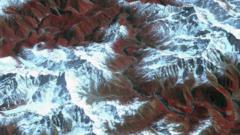In a significant move reflecting its commitment to hydropower, China has begun building an unprecedented hydropower dam in the Tibetan region, situated in the massive Yarlung Tsangpo canyon, known for its depth and length. The ceremony to kick off the construction was led by Chinese Premier Li Qiang. This ambitious project, estimated to cost around 1.2 trillion yuan (approximately $167 billion), has stirred controversy over its implications for millions of residents in India and Bangladesh who depend on the river that flows through their lands.
The Motuo Hydropower Station is designed to generate three times more energy compared to the existing Three Gorges Dam, leading experts to express alarm over China's newfound ability to manage and potentially divert the Yarlung Tsangpo river water, which flows into India's north-eastern states and beyond to Bangladesh, contributing to rivers like the Siang, Brahmaputra, and Jamuna. Indian officials, including Arunachal Pradesh's Chief Minister Pema Khandu, have raised the alarm, suggesting that the dam could drastically affect water levels in their territories, posing an existential threat to communities and ecosystems alike.
In January, India’s Ministry of External Affairs conveyed concerns to China, pressing for safeguards for downstream interests and demanding transparent consultations regarding such major projects. Meanwhile, Bangladesh has joined the calls for clarity regarding the potential impact of the dam, seeking further information from Beijing on how it would affect their water supply.
The Yarlung Tsangpo, which weaves through the Tibetan plateau and makes sharp elevation drops around the Namcha Barwa mountain, has long been viewed by Chinese authorities as a prime location for hydropower development. Plans reportedly include constructing extensive tunnels to expedite water diversion for energy generation. China's state media touts these developments as advances in clean energy and economic upliftment for rural Tibetans, yet critiques note a history of exploitation and suppression of Tibetan protests against such initiatives.
Environmental advocates express concerns that flooding due to the dam could devastate bioproductive Tibetan valleys and highlight the risks associated with constructing such infrastructure in a seismically active region. The unfolding situation could reshape the geopolitical landscape in South Asia, as downstream nations closely watch the effects of China's growing hydropower ambitions.
The Motuo Hydropower Station is designed to generate three times more energy compared to the existing Three Gorges Dam, leading experts to express alarm over China's newfound ability to manage and potentially divert the Yarlung Tsangpo river water, which flows into India's north-eastern states and beyond to Bangladesh, contributing to rivers like the Siang, Brahmaputra, and Jamuna. Indian officials, including Arunachal Pradesh's Chief Minister Pema Khandu, have raised the alarm, suggesting that the dam could drastically affect water levels in their territories, posing an existential threat to communities and ecosystems alike.
In January, India’s Ministry of External Affairs conveyed concerns to China, pressing for safeguards for downstream interests and demanding transparent consultations regarding such major projects. Meanwhile, Bangladesh has joined the calls for clarity regarding the potential impact of the dam, seeking further information from Beijing on how it would affect their water supply.
The Yarlung Tsangpo, which weaves through the Tibetan plateau and makes sharp elevation drops around the Namcha Barwa mountain, has long been viewed by Chinese authorities as a prime location for hydropower development. Plans reportedly include constructing extensive tunnels to expedite water diversion for energy generation. China's state media touts these developments as advances in clean energy and economic upliftment for rural Tibetans, yet critiques note a history of exploitation and suppression of Tibetan protests against such initiatives.
Environmental advocates express concerns that flooding due to the dam could devastate bioproductive Tibetan valleys and highlight the risks associated with constructing such infrastructure in a seismically active region. The unfolding situation could reshape the geopolitical landscape in South Asia, as downstream nations closely watch the effects of China's growing hydropower ambitions.
















